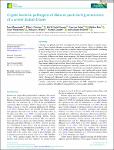Cryptic bacterial pathogens of diatoms peak during senescence of a winter diatom bloom
| dc.contributor.author | Branscombe, L | |
| dc.contributor.author | Harrison, EL | |
| dc.contributor.author | Choong, ZYD | |
| dc.contributor.author | Swink, C | |
| dc.contributor.author | Keys, M | |
| dc.contributor.author | Widdicombe, C | |
| dc.contributor.author | Wilson, WH | |
| dc.contributor.author | Cunliffe, M | |
| dc.contributor.author | Helliwell, K | |
| dc.date.accessioned | 2023-12-18T13:43:26Z | |
| dc.date.available | 2023-12-18T13:43:26Z | |
| dc.date.issued | 2023-11-30 | |
| dc.identifier.issn | 0028-646X | |
| dc.identifier.issn | 1469-8137 | |
| dc.identifier.uri | https://pearl.plymouth.ac.uk/handle/10026.1/21809 | |
| dc.description.abstract |
Summary Diatoms are globally abundant microalgae that form extensive blooms in aquatic ecosys-tems. Certain bacteria behave antagonistically towards diatoms, killing or inhibiting theirgrowth. Despite their crucial implications to diatom bloom and population health, knowledgeof diatom antagonists in the environment is fundamentally lacking. We report systematic characterisation of the diversity and seasonal dynamics of bacterialantagonists of diatoms via plaque assay sampling in the Western English Channel, where dia-toms frequently bloom. Unexpectedly, peaks in detection did not occur during characteristicspring diatom blooms, but coincided with a winter bloom ofCoscinodiscus, suggesting thatthese bacteria likely influence distinct diatom host populations. We isolated multiple bacterial antagonists, spanning 4 classes and 10 bacterial orders. Nota-bly, a diatom attaching RoseobacterPonticoccus alexandriiwas isolated multiple times, indi-cative of a persistent environmental presence. Moreover, many isolates had no prior reportsof antagonistic activity towards diatoms. We verified diatom growth inhibitory effects of eightisolates. In all cases tested, these effects were activated by pre-exposure to diatom organicmatter. Discovery of widespread ‘cryptic’ antagonistic activity indicates that bacterial patho-genicity towards diatoms is more prevalent than previously recognised. Finally, examination of the global biogeography of WEC antagonists revealed co-occurrence patterns with diatom host populations in marine waters globally. | |
| dc.format.extent | 1292-1307 | |
| dc.format.medium | Print-Electronic | |
| dc.language | en | |
| dc.publisher | Wiley | |
| dc.subject | algicidal | |
| dc.subject | Coscinodiscus | |
| dc.subject | diatom-bacteria interactions | |
| dc.subject | diatoms | |
| dc.subject | plaque assay | |
| dc.subject | Ponticoccus | |
| dc.title | Cryptic bacterial pathogens of diatoms peak during senescence of a winter diatom bloom | |
| dc.type | journal-article | |
| dc.type | Article | |
| plymouth.author-url | https://www.ncbi.nlm.nih.gov/pubmed/38037269 | |
| plymouth.issue | 3 | |
| plymouth.volume | 241 | |
| plymouth.publisher-url | http://dx.doi.org/10.1111/nph.19441 | |
| plymouth.publication-status | Published | |
| plymouth.journal | New Phytologist | |
| dc.identifier.doi | 10.1111/nph.19441 | |
| plymouth.organisational-group | |Plymouth | |
| plymouth.organisational-group | |Plymouth|Faculty of Science and Engineering | |
| plymouth.organisational-group | |Plymouth|Faculty of Science and Engineering|School of Biological and Marine Sciences | |
| plymouth.organisational-group | |Plymouth|REF 2021 Researchers by UoA | |
| plymouth.organisational-group | |Plymouth|Users by role | |
| plymouth.organisational-group | |Plymouth|Users by role|Academics | |
| plymouth.organisational-group | |Plymouth|REF 2021 Researchers by UoA|UoA07 Earth Systems and Environmental Sciences | |
| plymouth.organisational-group | |Plymouth|REF 2028 Researchers by UoA | |
| plymouth.organisational-group | |Plymouth|REF 2028 Researchers by UoA|UoA07 Earth Systems and Environmental Sciences | |
| dc.publisher.place | England | |
| dcterms.dateAccepted | 2023-10-27 | |
| dc.date.updated | 2023-12-18T13:42:59Z | |
| dc.rights.embargodate | 2023-12-19 | |
| dc.identifier.eissn | 1469-8137 | |
| rioxxterms.versionofrecord | 10.1111/nph.19441 |


